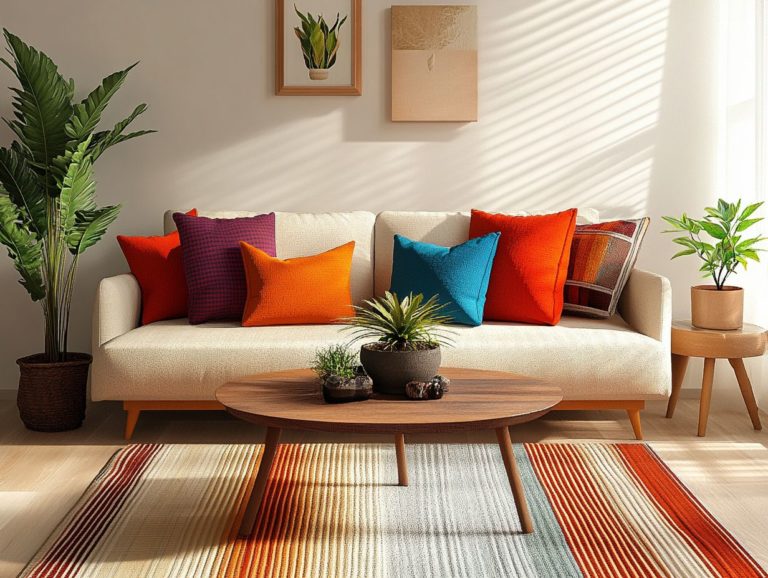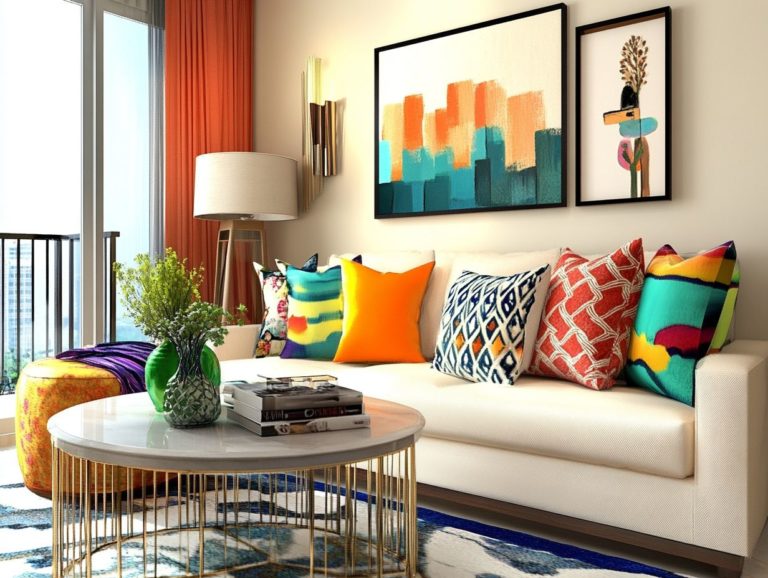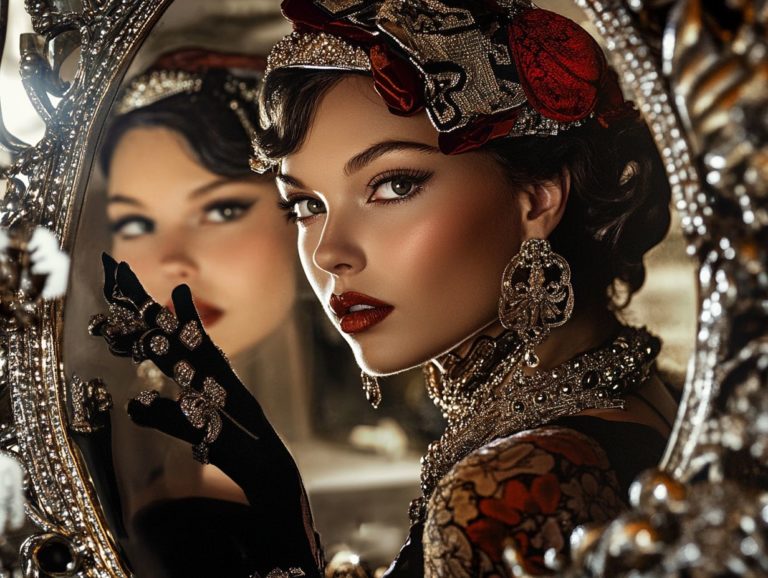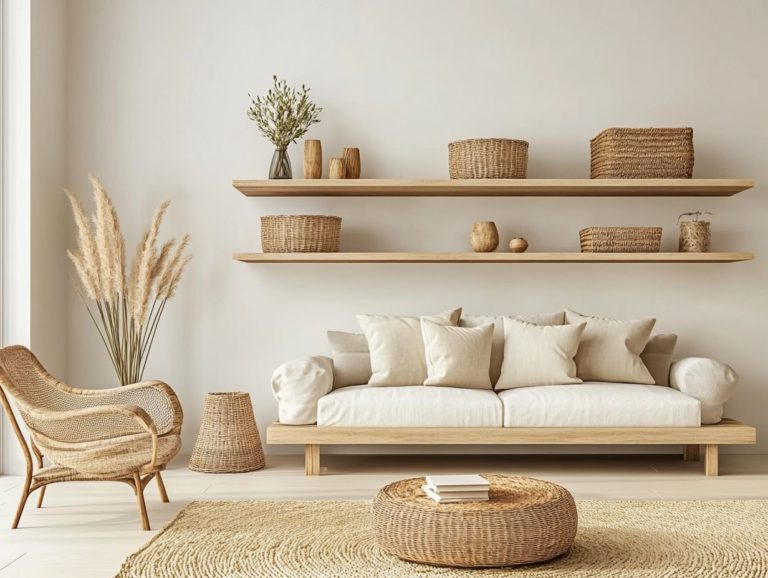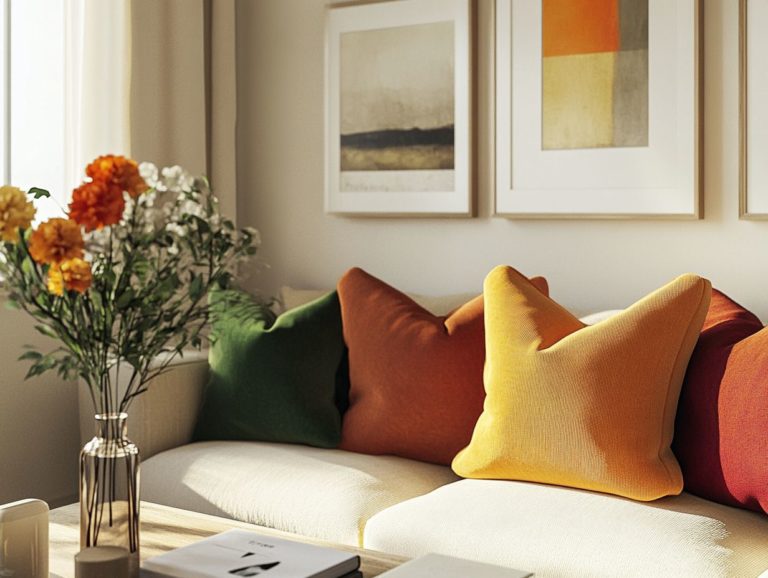What are the Most Popular Styles in Home Accessories?
Are you seeking to revitalize your living space but feeling a bit lost on where to begin? Home decor styles have the power to transform your environment, serving as a canvas for your unique personality and taste.
This article delves into 15 popular home decor styles, showcasing their key characteristics, color palettes, and essential accessories. You’ll find practical tips on how to seamlessly incorporate these aesthetics into your own home.
Immerse yourself in this journey to uncover the ideal style for your personal sanctuary!
Contents
- Key Takeaways:
- 1. Minimalist
- 2. Bohemian
- 3. Industrial
- 4. Scandinavian
- 5. Farmhouse
- 6. Mid-Century Modern
- 7. Coastal
- 8. Traditional
- 9. Rustic
- 10. Contemporary
- 11. Eclectic
- 12. Art Deco
- 13. Shabby Chic
- 14. Asian
- 15. Vintage
- What Are the Key Characteristics of Each Style?
- Frequently Asked Questions
- What are the Most Popular Styles in Home Accessories?
- What defines the modern style in home accessories?
- How can I incorporate the farmhouse style in my home accessories?
- What elements make up a bohemian style in home accessories?
- Is the minimalist style in home accessories suitable for small spaces?
- How can I add a touch of traditional style in my home accessories?
Key Takeaways:
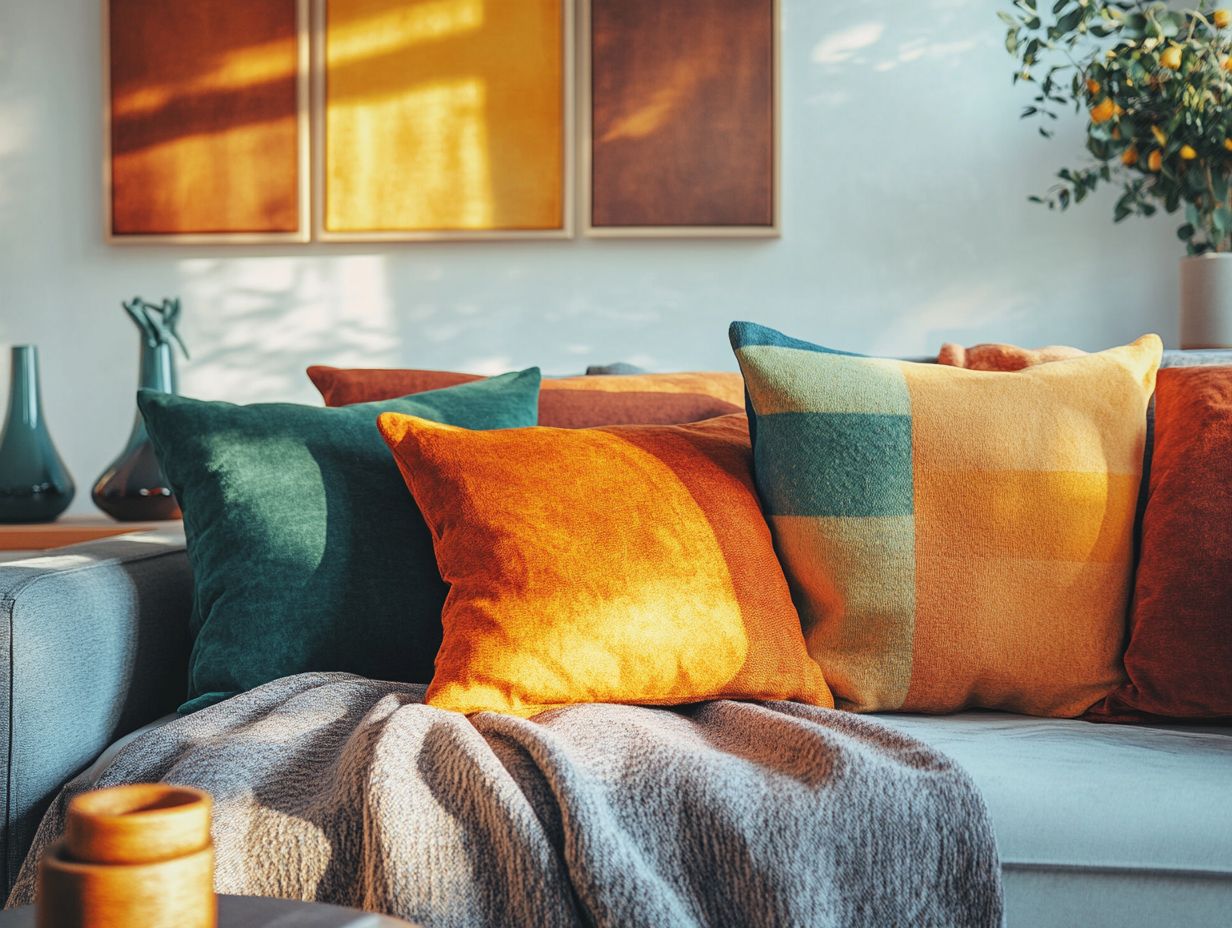
- Minimalist, Scandinavian, and Contemporary are the top three most popular styles in home accessories.
- Incorporating natural elements, neutral colors, and simple designs are key characteristics of these popular styles.
- Mixing and matching different styles can add depth and personality to a home.
1. Minimalist
Minimalist design emphasizes simplicity, functionality, and a decluttered aesthetic. This approach isn t just about cutting out the unnecessary; it s about elevating the impact of every piece of furniture and decor in your space.
With its clean lines and neutral palettes, minimalism invites a profound appreciation for quality materials and craftsmanship, evident in the contemporary designs of renowned figures like Stephanie Thatenhorst and David Thulstrup. Embracing a minimalist approach can significantly enhance your home decor and elevate your living experience!
Focusing on open spaces, this design philosophy cultivates tranquility and order. It allows for easier navigation and a more harmonious environment. Light is vital in minimalist interiors; large windows and unobtrusive lighting fixtures enhance natural illumination, contributing to a serene atmosphere. Color schemes typically revolve around whites, grays, and muted tones that evoke a calm, cohesive feel.
You can see influences from Scandinavian and Japanese aesthetics in this practice. Scandinavian designs often feature furniture that beautifully balances functionality with elegance, while Japanese minimalism draws inspiration from nature, introducing zen-like qualities into your home. Both styles celebrate the beauty of imperfections, showcasing curated materials that add depth while honoring minimalism’s essence.
2. Bohemian
The bohemian look captivates with vibrant colors, eclectic decor, and a carefree spirit that invites your individuality and creativity into your home.
To achieve this style, blend an array of textiles, from richly patterned tapestries to soft, inviting throws. Incorporate various cultural artifacts like woven baskets or handcrafted pottery. Each piece tells a story, allowing your environment to reflect personal journeys and experiences, standing in stark contrast to the minimalist aesthetic that prioritizes simplicity.
The bohemian approach encourages you to layer visual textures and patterns. This creates a warm, inviting space that celebrates diversity and the beauty of imperfection. The result is a unique narrative distinctly yours, showcasing your personal flair and life s tapestry.
3. Industrial
Industrial style takes you on a journey through warehouses and factories, showcasing raw materials and exposed structures. The dark tones create a bold, urban aesthetic that s hard to resist.
This design philosophy embraces elements like metal fixtures, reclaimed wood, and concrete accents, crafting an edgy yet welcoming atmosphere. You ll find large, open spaces inspiring a sense of freedom, often complemented by soaring ceilings and expansive windows that invite natural light.
Influential figures such as Jean Prouv and Charles Eames have significantly shaped contemporary industrial decor. They skillfully merged function with form to create pieces that are both practical and visually striking. Today, the fusion of vintage industrial pieces with modern furnishings continues to captivate designers and homeowners alike, making it a cherished choice for urban interiors.
Explore these styles to find the perfect fit for your home!
Scandinavian interior design captures attention with its cozy, minimalist style. It emphasizes comfort, creating spaces that feel welcoming.
This approach reveals a profound appreciation for simplicity and often features light color palettes that create airy and inviting atmospheres. Natural materials like wood, stone, and wool add tactile warmth and a seamless connection to the outdoors.
The concept of Swedish lagom meaning “just the right amount” plays a pivotal role here. This philosophy encourages you to cultivate balanced living environments that foster wellness and serenity.
By seamlessly blending form and function with a touch of coziness, Scandinavian design creates spaces that truly feel like home.
5. Farmhouse
The modern farmhouse style artfully merges traditional charm with contemporary design. This creates an interior that is both cozy and sophisticated.
Imagine stepping into a space where rustic elements harmonize effortlessly with modern aesthetics. Shiplap walls introduce rich texture and a hint of history, serving as a warm canvas for your carefully chosen vintage-inspired decor.
Warm color schemes soft whites, muted grays, and earthy tones enhance the inviting atmosphere. Bursts of color can emerge through thoughtfully selected accessories or artwork.
Renowned designers like Stephanie Thatenhorst excel at weaving these elements together. They craft spaces that feel at once timeless and refreshingly modern.
The use of reclaimed materials and handmade furnishings encapsulates the spirit of modern farmhouse living. This invites not just comfort but a genuine sense of belonging.
6. Mid-Century Modern
Mid-century modern interior design captivates with its clean lines and organic forms. It embodies a post-war optimism that remains celebrated today through iconic creations from visionaries like Charles Eames and esteemed brands such as Vitra.
This style places a premium on functionality, blending practical elements with aesthetic appeal. You ll find furnishings crafted with an emphasis on comfort and usability, designed to integrate seamlessly into your daily life.
The simple yet striking silhouettes not only exude elegance but also serve as a nod to an era that championed innovation. The enduring legacy of mid-century modern design is evident in contemporary decor.
Its timeless principles inspire fresh interpretations that resonate with current lifestyles. This showcases how classic design continues to influence and enrich your living spaces, making it a cherished choice for those who appreciate the art of living well.
7. Coastal

Transform your home into a haven of relaxation! Coastal decor beautifully embodies the essence of seaside living, inviting light, airy spaces and vibrant colors that evoke the serenity of sunlit beaches and gentle ocean waves.
Want a coastal vibe? Add marine elements like shells and driftwood to bring the beach indoors! Soft textiles such as linen and cotton are essential, inviting you to unwind and fostering a tranquil atmosphere.
Using a color palette inspired by nature think sandy beige, seafoam green, and crisp whites evokes the feeling of a beach getaway. Maximizing natural light is crucial; it not only makes your spaces feel larger but also reflects the beautiful hues found near the coast.
Explore more design ideas to create your own inspired space!
8. Traditional
Traditional interior design embodies classic and beautiful design, inviting you to immerse yourself in rich colors and classic furnishings.
Intricate details evoke a sense of history and comfort. In this style, you’ll often find luxurious fabrics like velvet and brocade, which add depth and richness to your space.
Antique furniture is more than just a visual delight; it tells a story and infuses warmth and nostalgia into your home. Detailed woodwork showcases craftsmanship influenced by historical styles.
Examples include ornate crown molding and hand-carved furniture pieces, which highlight the beauty of Baroque and Georgian aesthetics.
Elements like Persian rugs and heavy draperies enhance this traditional look, creating a harmonious blend of beauty and practicality that speaks to anyone who appreciates a refined living environment.
9. Rustic
Rustic design invites you to embrace the beauty of nature, crafting a warm atmosphere that transports you to a cozy country house retreat.
By incorporating elements like exposed wood beams, you instantly add authenticity and character to your space.
Stone accents, whether featured in fireplace surrounds or as a feature wall, add timeless elegance and stability. Handmade crafts, such as woven baskets or pottery, breathe personality into your decor.
These elements evoke feelings of nostalgia and comfort. When they harmonize, they not only enhance aesthetic appeal but also create a unique sanctuary.
This sanctuary invites your family and friends to unwind and savor the exquisite blend of nature and artistry.
10. Contemporary
Contemporary interior design is a constantly evolving style that captures current trends and technologies.
It infuses vibrant colors and innovative materials to craft dynamic living spaces. This approach emphasizes a seamless blend of comfort and sophistication, prioritizing functionality over ornamentation.
By incorporating modern furniture and art, it creates an open and airy atmosphere, encouraging a harmonious flow between different spaces.
You ll often find designers using geometric shapes and minimalistic forms, enhancing visual appeal and cultivating a sense of tranquility.
Sustainable materials and eco-friendly practices also play a big role, reflecting a commitment to style and environmental responsibility.
11. Eclectic
Eclectic decor is your canvas, celebrating diversity through a captivating mix of styles, colors, and textures.
This is your chance to showcase your unique personality and creativity in your interior design.
By thoughtfully curating pieces from various eras like a vintage gem or a striking contemporary artwork you can craft a vibrant atmosphere with a sense of cohesion.
Balancing bold statement items with subdued backgrounds enhances the overall aesthetic, ensuring no single element steals the spotlight.
Incorporating complementary colors and materials is equally important. For instance, pairing a rustic wooden table with sleek metal chairs creates engaging visual contrast.
Ultimately, the aim is to achieve a harmonious blend that reflects your personal tastes while inviting warmth and intrigue into your space.
12. Art Deco
Art Deco interior design captivates with bold patterns, luxurious materials, and vibrant colors.
It embodies the glamour and sophistication of the 1920s and 30s while seamlessly merging aesthetic appeal with functional design.
This style showcases the harmonious relationship between beauty and practicality. Influenced by pioneers like mile-Jacques Ruhlmann and architects such as Hugh Ferriss, Art Deco has left a mark on modern interiors.
Today s designers often look to this era for inspiration, integrating sculptural forms and rich textures into their creations.
The enduring legacy of Art Deco serves as a timeless reminder of its lasting allure, with many modern pieces reflecting its elegant philosophy.
13. Shabby Chic
Shabby chic interior design beautifully blends vintage elegance with rustic charm. It utilizes distressed furniture and soft pastel hues to create a cozy and welcoming space.
The heart of this style lies in its mix of floral patterns, delicate lace accents, and aged furnishings that tell their own story.
Transform your space with charming shabby chic elements that blend beautifully with modern decor! For example, soften a sleek, minimalist area by introducing vintage armchairs adorned with faded florals or a coffee table with a weathered finish.
Adding soft textiles like linen and cotton enhances the relaxed vibe, allowing for a seamless integration that feels both fresh and nostalgically familiar.
14. Asian

Asian interior design invites you to embrace minimalism and balance. It focuses on natural materials and harmonious layouts that create peace and tranquility in your living spaces.
Incorporating elements like bamboo a symbol of strength and flexibility helps create environments that resonate beautifully with nature. Water features often add soothing sounds and reflections, inspiring a deeper sense of serenity.
This style features spacious layouts that allow energy to flow freely, or ‘qi,’ fostering openness and mindfulness in your surroundings. Spirituality plays a key role, guiding design choices that honor the earth s gifts and the connection between individuals and their environment, enhancing your quality of life and well-being.
15. Vintage
Vintage style in interior design invites you to indulge in nostalgia with retro furnishings, antique accessories, and a warm color palette that connects you to the past.
By blending these timeless elements with contemporary pieces, you can craft a space that feels inviting and dynamic. For instance, juxtapose an antique coffee table with sleek modern chairs to add character while maintaining a fresh aesthetic.
Incorporating modern lighting fixtures alongside cherished heirlooms accentuates architectural features and bridges the gap between eras. This imbuing each room with a narrative that transcends time and trends.
What Are the Key Characteristics of Each Style?
The key characteristics of popular interior design styles minimalism, bohemian, industrial, Scandinavian, and rustic highlight the various approaches to home decor and the unique atmospheres each can create.
Each style brings a distinct flavor into your space. Minimalism, for instance, embraces neutral color palettes and a sleek aesthetic that prioritizes functionality. In contrast, bohemian designs radiate an eclectic vibe filled with vibrant hues and a mix of textures that evoke warmth and creativity.
The industrial style boldly incorporates raw materials like exposed brick and metal accents, giving your interiors an urban edge. Scandinavian design, known for its simplicity, uses light colors and natural materials to create a calming environment.
Rustic d cor, with its warm tones and organic elements, creates a cozy atmosphere that invites relaxation. Each of these styles is influenced by contemporary trends and prominent designers, making them ever-evolving and captivating in today s interior landscape.
How Can One Incorporate These Styles into Their Home?
Incorporating different interior design styles requires careful planning. Blend elements that reflect your personality while maintaining a unified style throughout the space.
To achieve that harmonious blend, start by establishing a color palette that ties together the different styles. Consider opting for a neutral base and then introducing accent colors that showcase each style’s distinct characteristics. For example, imagine combining sleek modern furniture with charming vintage decor. Select a deep navy for your sofa and pair it with antique side tables that boast brushed gold accents. Now that s striking!
Don t underestimate the power of texture to add visual interest. A plush rug can soften the hard lines of industrial designs. Soft fabrics can beautifully balance sleek surfaces. Successful designs often draw from real-life examples. Think of mid-century modern chairs paired with contemporary art pieces. They illustrate how contrasting aesthetics can complement one another in a wonderfully cohesive way.
What Are the Most Popular Colors and Patterns in Each Style?
The most popular colors and patterns in interior design styles vary significantly. Each style utilizes distinct palettes and motifs to elevate the desired atmosphere and aesthetics.
Take rustic decor, for example. It often embraces earthy tones like deep browns, warm beiges, and muted greens, which evoke a sense of nature and comfort. Patterns such as plaid or houndstooth, crafted from natural fabrics, contribute to this inviting ambiance.
In contrast, bohemian design revels in bold colors. Think vibrant reds, sunny yellows, and rich purples that create an atmosphere of fun and eclecticism. Layers of patterns, including geometric prints and floral motifs, enhance this spirited aesthetic, inviting creativity and individuality into your space.
How Can One Mix and Match Different Styles in Their Home?
Mixing and matching various interior design styles in your home can create a truly unique and personalized space. It requires thoughtful consideration to achieve harmony and balance.
Successful blending demands a strategic approach, especially when it comes to maintaining a cohesive color palette that unifies diverse elements. Select a few base colors to anchor your design, allowing for vibrant accents that catch the eye without clashing.
When choosing furniture, opt for pieces that complement rather than compete, enhancing the overall ambiance of your space.
For instance, a sleek mid-century modern sofa can be beautifully paired with a vintage bohemian rug, creating an inviting focal point that tells a story. Similarly, combining industrial lighting with softer, traditional furnishings can create an intriguing balance, showcasing the beauty of eclectic decor.
What Are the Must-Have Home Accessories for Each Style?
Each interior design style you explore brings its own essential home accessories, so it’s important to know what to know before buying home accessories that elevate both the aesthetic and functionality of your space.
For example, if you’re drawn to industrial design, incorporating statement lighting like striking metal pendant lamps can be crucial. This establishes an edgier vibe that harmonizes beautifully with raw materials, specifically exposed bricks and pipes.
On the other hand, if Scandinavian aesthetics speak to you, embrace soft textiles. Think luxurious plush throws and light, airy curtains to infuse warmth and coziness while staying true to a minimalist ethos.
These accessories do more than just enhance visual appeal. They add layers of comfort and personality, transforming your environment into a crafted and inviting haven.
Frequently Asked Questions
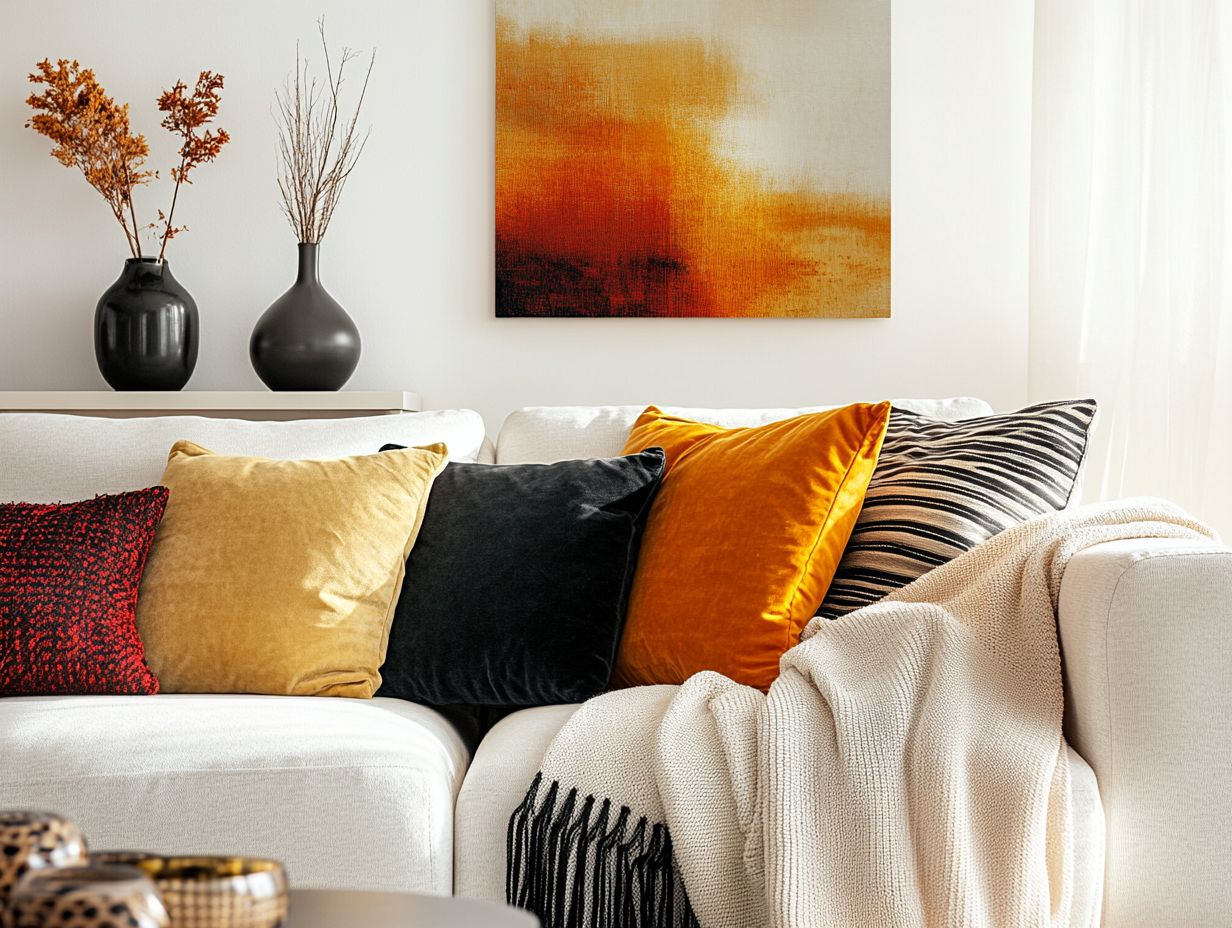
What are the Most Popular Styles in Home Accessories?
The most popular styles in home accessories include modern, farmhouse, bohemian, minimalist, traditional, and rustic, with many homeowners interested in exploring trends in home accessories to enhance their decor.
What defines the modern style in home accessories?
The modern style in home accessories is characterized by clean lines, sleek finishes, and a minimalist approach to decor, making it essential to know what the most versatile home accessories are.
How can I incorporate the farmhouse style in my home accessories?
Transform your home accessories with a charming farmhouse style! Look for natural materials and simple, rustic designs in neutral colors.
What elements make up a bohemian style in home accessories?
Embrace a bohemian style by mixing patterns, textures, and colors. This style is all about free-spirited and eclectic expression.
Is the minimalist style in home accessories suitable for small spaces?
The minimalist style is perfect for small spaces. It focuses on functionality and simplicity, maximizing your limited area.
How can I add a touch of traditional style in my home accessories?
Add a touch of tradition with elegant patterns and decorative designs. Classic color schemes will enhance the traditional vibe in your accessories.

